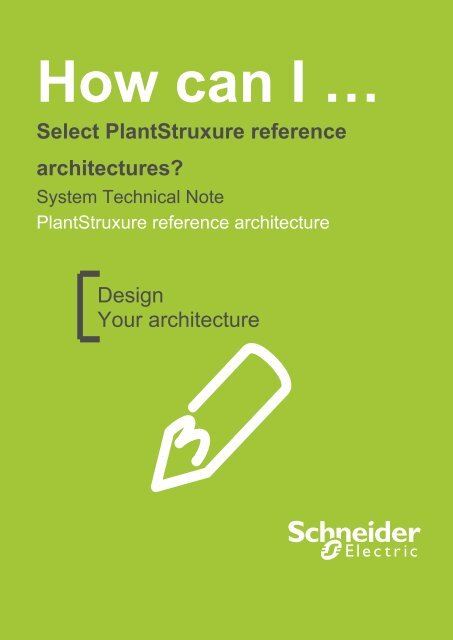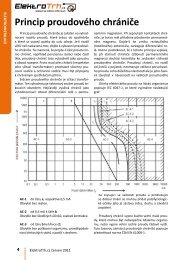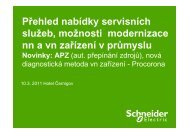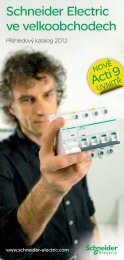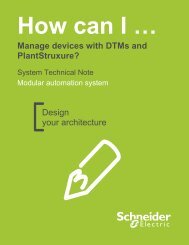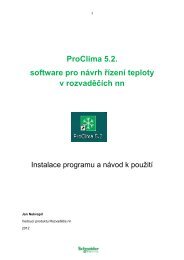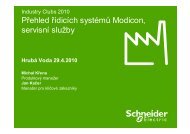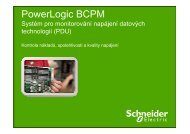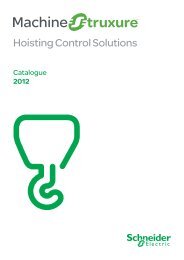Select PlantStruxure reference architectures? - Schneider Electric ...
Select PlantStruxure reference architectures? - Schneider Electric ...
Select PlantStruxure reference architectures? - Schneider Electric ...
Create successful ePaper yourself
Turn your PDF publications into a flip-book with our unique Google optimized e-Paper software.
Important InformationNoticePeople responsible for the application, implementation and use of this document must make surethat all necessary design considerations have been taken into account and that all laws, safetyand performance requirements, regulations, codes, and applicable standards have been obeyedto their full extent.<strong>Schneider</strong> <strong>Electric</strong> provides the resources specified in this document. These resources can beused to minimize engineering efforts, but the use, integration, configuration, and validation of thesystem is the user’s sole responsibility. Said user must ensure the safety of the system as awhole, including the resources provided by <strong>Schneider</strong> <strong>Electric</strong> through procedures that the userdeems appropriate.This document is not comprehensive for any systems using the given architecture and does notabsolve users of their duty to uphold the safety requirements for the equipment used in theirsystems, or compliance with both national or international safety laws and regulations.Readers are considered to already know how to use the products described in this document.This document does not replace any specific product documentation.The following special messages may appear throughout this documentation or on the equipmentto warn of potential hazards or to call attention to information that clarifies or simplifies aprocedure.The addition of this symbol to a Danger or Warning safety label indicates that anelectrical hazard exists, which will result in personal injury if the instructions are notfollowed.This is the safety alert symbol. It is used to alert you to potential personal injury hazards.Obey all safety messages that follow this symbol to avoid possible injury or death.DANGERDANGER indicates an imminently hazardous situation which, if not avoided, will result in deathor serious injury.Failure to follow these instructions will result in death or serious injury.© 2012 <strong>Schneider</strong> <strong>Electric</strong> All Rights Reserved3
WARNINGWARNING indicates a potentially hazardous situation which, if not avoided, can result in deathor serious injury.Failure to follow these instructions can cause death, serious injury or equipmentdamage.CAUTIONCAUTION indicates a potentially hazardous situation which, if not avoided, can result in minoror moderate injury.Failure to follow these instructions can result in injury or equipment damage.Before You BeginNOTICENOTICE is used to address practices not related to physical injury.Failure to follow these instructions can result in equipment damage.Note: <strong>Electric</strong>al equipment should be installed, operated, serviced, and maintained only byqualified personnel. No responsibility is assumed by <strong>Schneider</strong> <strong>Electric</strong> for any consequencesarising out of the use of this material.A qualified person is one who has skills and knowledge related to the construction, operation andinstallation of electrical equipment, and has received safety training to recognize and avoid thehazards involved.This automation equipment and related software is used to control a variety of industrialprocesses. The type or model of automation equipment suitable for each application will varydepending on factors such as the control function required, degree of protection required,production methods, unusual conditions and government regulations etc. In some applicationsmore than one processor may be required when backup redundancy is needed.Only the user can be aware of all the conditions and factors present during setup, operation andmaintenance of the solution. Therefore only the user can determine the automation equipmentand the related safeties and interlocks which can be properly used. When selecting automationand control equipment and related software for a particular application, the user should refer to© 2012 <strong>Schneider</strong> <strong>Electric</strong> All Rights Reserved4
the applicable local and national standards and regulations. The National Safety Council’sAccident Prevention Manual also provides much useful information.Ensure that appropriate safeties and mechanical/electrical interlocks protection have beeninstalled and are operational before placing the equipment into service. All mechanical/electricalinterlocks and safeties protection must be coordinated with the related automation equipment andsoftware programming.Note: Coordination of safeties and mechanical/electrical interlocks protection is outside the scopeof this document.START UP AND TESTFollowing installation but before using electrical control and automation equipment for regularoperation, the system should be given a start up test by qualified personnel to verify the correctoperation of the equipment. It is important that arrangements for such a check be made and thatenough time is allowed to perform complete and satisfactory testing.WARNINGEQUIPMENT OPERATION HAZARDFollow all start up tests as recommended in the equipment documentation.Store all equipment documentation for future <strong>reference</strong>.Software testing must be done in both simulated and real environments.Failure to follow these instructions can cause death, serious injury or equipmentdamage.Verify that the completed system is free from all short circuits and grounds, except those groundsinstalled according to local regulations (according to the National <strong>Electric</strong>al Code in the USA, forexample). If high-potential voltage testing is necessary, follow recommendations in the equipmentdocumentation to prevent accidental equipment damage.Before energizing equipment:Remove tools, meters, and debris from equipmentClose the equipment enclosure doorRemove ground from incoming power linesPerform all start-up tests recommended by the manufacturer© 2012 <strong>Schneider</strong> <strong>Electric</strong> All Rights Reserved5
OPERATION AND ADJUSTMENTSThe following precautions are from NEMA Standards Publication ICS 7.1-1995 (English versionprevails):Regardless of the care exercised in the design and manufacture of equipment or in the selectionand rating of components; there are hazards that can be encountered if such equipment isimproperly operated.It is sometimes possible to misadjust the equipment and thus produce unsatisfactory or unsafeoperation. Always use the manufacturer’s instructions as a guide for functional adjustments.Personnel who have access to these adjustments should be familiar with the equipmentmanufacturer’s instructions and the machinery used with the electrical equipment.Only those operational adjustments actually required by the operator should be accessible to theoperator. Access to other controls should be restricted to prevent unauthorized changes inoperating characteristics.WARNINGUNEXPECTED EQUIPMENT OPERATIONOnly use software tools approved by <strong>Schneider</strong> <strong>Electric</strong> for use with this equipment.Update your application program every time you change the physical hardwareconfiguration.Failure to follow these instructions can cause death, serious injury or equipmentdamage.INTENTIONThis document is intended to provide a quick introduction to the described system. It is notintended to replace any specific product documentation, nor any of your own designdocumentation. On the contrary, it offers information additional to the product documentation oninstallation, configuration and implementing the system.The architecture described in this document is not a specific product in the normal commercialsense. It describes an example of how <strong>Schneider</strong> <strong>Electric</strong> and third-party components may beintegrated to fulfill an industrial application.A detailed functional description or the specifications for a specific user application is not part ofthis document. Nevertheless, the document outlines some typical applications where the systemmight be implemented.6© 2012 <strong>Schneider</strong> <strong>Electric</strong> All Rights Reserved
The architecture described in this document has been fully tested in our laboratories using all thespecific <strong>reference</strong>s you will find in the component list near the end of this document. Of course,your specific application requirements may be different and will require additional and/or differentcomponents. In this case, you will have to adapt the information provided in this document toyour particular needs. To do so, you will need to consult the specific product documentation of thecomponents that you are substituting in this architecture. Pay particular attention in conforming toany safety information, different electrical requirements and normative standards that would applyto your adaptation.It should be noted that there are some major components in the architecture described in thisdocument that cannot be substituted without completely invalidating the architecture,descriptions, instructions, wiring diagrams and compatibility between the various software andhardware components specified herein. You must be aware of the consequences of componentsubstitution in the architecture described in this document as substitutions may impair thecompatibility and interoperability of software and hardware.CAUTIONEQUIPMENT INCOMPATIBILITY OR INOPERABLE EQUIPMENTRead and thoroughly understand all hardware and software documentation before attemptingany component substitutions.Failure to follow these instructions can result in injury or equipment damage.© 2012 <strong>Schneider</strong> <strong>Electric</strong> All Rights Reserved7
This document is intended to describe classes of <strong>reference</strong> architecture for <strong>PlantStruxure</strong>. Theseclasses of architecture can be used for multiple vertical applications.DANGERHAZARD OF ELECTRIC SHOCK, BURN OR EXPLOSIONOnly qualified personnel familiar with low and medium voltage equipment are to performwork described in this set of instructions. Workers must understand the hazards involved inworking with or near low and medium voltage circuits.Perform such work only after reading and understanding all of the instructions contained inthis bulletin.Turn off all power before working on or inside equipment.Use a properly rated voltage sensing device to confirm that the power is off.Before performing visual inspections, tests, or maintenance on the equipment, disconnectall sources of electric power. Assume that all circuits are live until they have beencompletely de-energized, tested, grounded, and tagged. Pay particular attention to thedesign of the power system. Consider all sources of power, including the possibility of backfeeding.Handle this equipment carefully and install, operate, and maintain it correctly in order for itto function properly. Neglecting fundamental installation and maintenance requirementsmay lead to personal injury, as well as damage to electrical equipment or other property.Beware of potential hazards, wear personal protective equipment and take adequate safetyprecautions.Do not make any modifications to the equipment or operate the system with the interlocksremoved. Contact your local field sales representative for additional instruction if theequipment does not function as described in this manual.Carefully inspect your work area and remove any tools and objects left inside theequipment.Replace all devices, doors and covers before turning on power to this equipment.All instructions in this manual are written with the assumption that the customer has takenthese measures before performing maintenance or testing.Failure to follow these instructions will result in death or serious injury.© 2012 <strong>Schneider</strong> <strong>Electric</strong> All Rights Reserved8
The STN CollectionThe implementation of an automation project includes five main phases: <strong>Select</strong>ion, Design,Configuration, Implementation and Operation. To help you develop a project based on thesephases, <strong>Schneider</strong> <strong>Electric</strong> has created the Tested, Validated, Documented Architecture andSystem Technical Note.A Tested, Validated, Documented Architecture (TVDA) provides technical guidelines andrecommendations for implementing technologies to address your needs and requirements, Thisguide covers the entire scope of the project life cycle, from the <strong>Select</strong>ion to the Operation phase,providing design methodologies and source code examples for all system components.A System Technical Note (STN) provides a more theoretical approach by focusing on a particularsystem technology. These notes describe complete solution offers for a system, and thereforesupport you in the <strong>Select</strong>ion phase of a project. The TVDAs and STNs are related andcomplementary. In short, you will find technology fundamentals in an STN and theircorresponding applications in one or several TVDAs.Development EnvironmentEach TVDA or STN has been developed in one of our solution platform labs using a typical<strong>PlantStruxure</strong> architecture.<strong>PlantStruxure</strong>, the process automation system from <strong>Schneider</strong> <strong>Electric</strong>, is a collaborativearchitecture that allows industrial and infrastructure companies to meet their automation needswhile at the same time addressing their growing energy efficiency requirements. In a singleenvironment, measured energy and process data can be analyzed to yield a holistically optimizedplant.© 2012 <strong>Schneider</strong> <strong>Electric</strong> All Rights Reserved9
© 2012 <strong>Schneider</strong> <strong>Electric</strong> All Rights Reserved10
Table of Contents1. Introduction 131.1. Purpose 131.2. Customer challenges 141.3. <strong>PlantStruxure</strong> architecture overview 141.4. <strong>PlantStruxure</strong> <strong>reference</strong> architecture principles 161.5. Glossary 162. <strong>Select</strong>ion 172.1. Reference architecture description 172.2. <strong>PlantStruxure</strong> technological axis 182.3. <strong>PlantStruxure</strong> functional axis 202.4. Application axis 212.5. <strong>PlantStruxure</strong> Libraries 213. <strong>PlantStruxure</strong> global <strong>reference</strong> architecture 233.1. Global <strong>reference</strong> architecture structuring 233.2. Overall network architecture 233.3. <strong>PlantStruxure</strong> centralized architecture 253.4. <strong>PlantStruxure</strong> modular architecture 263.5. <strong>PlantStruxure</strong> large process architecture 293.6. <strong>PlantStruxure</strong> global architecture selection summary 324. Control room <strong>reference</strong> <strong>architectures</strong> 334.1. Control room architecture structuring 334.2. <strong>PlantStruxure</strong> compact control room 344.3. <strong>PlantStruxure</strong> process control room 354.4. <strong>PlantStruxure</strong> plant operation center 364.5. Control room architecture selection summary 385. Functional unit <strong>reference</strong> <strong>architectures</strong> 395.1. Functional unit architecture structuring 395.2. <strong>PlantStruxure</strong> traditional functional unit 435.3. <strong>PlantStruxure</strong> optimized functional unit 455.4. <strong>PlantStruxure</strong> high service functional unit 48© 2012 <strong>Schneider</strong> <strong>Electric</strong> All Rights Reserved11
6. <strong>PlantStruxure</strong> <strong>reference</strong> architecture examples 557. Appendix 597.1. Glossary 597.2. Graphics 60© 2012 <strong>Schneider</strong> <strong>Electric</strong> All Rights Reserved12
1 – Introduction1. Introduction1.1. PurposeThe intent of this system technical note is to provide guidelines and recommendations to assist inselecting the <strong>PlantStruxure</strong> <strong>reference</strong> architecture that corresponds to the process or projectrequirements.<strong>PlantStruxure</strong>, the Process Automation System from <strong>Schneider</strong> <strong>Electric</strong>, is a collaborative systemthat:Allows industrial and infrastructure companies to meet their automation needsDelivers on growing energy management requirements<strong>PlantStruxure</strong> system <strong>architectures</strong> are classified in several <strong>reference</strong> system <strong>architectures</strong> thatare described in terms of key hardware and software components, and the interfaces andinteractions between these components. The same <strong>reference</strong> architecture covers differentverticals applications from field to enterprise networks. All <strong>reference</strong> <strong>architectures</strong> are tested,validated and documented.Figure 1: <strong>PlantStruxure</strong> modelThis STN provides a common and readily understandable <strong>reference</strong> point for end users, systemintegrators, OEMs, sales people, business support and other parties.This release only takes Plant <strong>architectures</strong> into consideration and does not cover telemetry andremote SCADA <strong>architectures</strong>.© 2012 <strong>Schneider</strong> <strong>Electric</strong> All Rights Reserved13
1 – Introduction1.2. Customer challengesFor sales and pre-sales forces, the main objective is to provide guidance about the features andsize of a system. The goals are:To convince customersTo influence consultants for suitable solutionsThe main objective of the SAE is to reuse a documented <strong>reference</strong> architecture to control thelimits of the system.For Engineering (internal or system integrator) the goal is to:Provide a system benchmark to guide design and implementationReuse a pre-defined architecture and therefore reduce engineering time1.3. <strong>PlantStruxure</strong> architecture overviewThe following drawing represents a generic <strong>PlantStruxure</strong> architecture showing the differentnetwork levels: operation network, control network and device network.This release does not integrate multi-site topologies, therefore telemetry and remote SCADA<strong>architectures</strong> will be described in a future release. A STN is dedicated to the description of theseclasses of architecture.Operation networkControlnetworkDevicenetworkFigure 2: <strong>PlantStruxure</strong> architecture example14© 2012 <strong>Schneider</strong> <strong>Electric</strong> All Rights Reserved
1 – Introduction1.4. <strong>PlantStruxure</strong> <strong>reference</strong> architecture principlesThe aim of using pre-tested <strong>reference</strong> <strong>architectures</strong> is to reduce project development time andrisk.The definition of automation system <strong>architectures</strong> from project specification (P&ID, devices list) isnot based only on the product catalog , but also on <strong>reference</strong> <strong>architectures</strong> catalog. Therefore,each system is based on pre-tested <strong>architectures</strong>. A customization is required to adapt theselected architecture to meet the project requirements and constraints.From customer requirements…ProjectrequirementsServicesPsXProductsPSxcatalog ProductcatalogCustomer SystemCustomerSolutionPSxReferencearchitectureCatalogTVDA guides…to customer solutionFigure 3: <strong>PlantStruxure</strong> <strong>reference</strong> <strong>architectures</strong> model1.5. GlossaryA glossary is available in the appendix chapter of this document. Please refer to it whenevernecessary.16© 2012 <strong>Schneider</strong> <strong>Electric</strong> All Rights Reserved
2 – <strong>Select</strong>ion2. <strong>Select</strong>ion2.1. Reference architecture description<strong>PlantStruxure</strong> automation system provides a solution for process applications such as waterplant, cement plant, mining plant, or food and beverage plant.Customers’ systems are designed using <strong>reference</strong> <strong>architectures</strong>. Some are designed for theoverall control systems and some are designed for more specific elements such as the controlroom or the functional units.Therefore, <strong>PlantStruxure</strong> <strong>reference</strong> <strong>architectures</strong> are a combination of a control room architectureand several functional unit <strong>architectures</strong> that are assembled following an overall networkarchitecture topology.The control room architecture includes all the components that allow monitoring and control of theentire process. The functional unit architecture integrates the control system and the peripherals.Operation networkControl roomArchitectureOverallnetworkarchitectureControlnetworkDevicenetworkFunctionalunitArchitectureFigure 4: <strong>PlantStruxure</strong> architecture structuringA comprehensive description of a <strong>PlantStruxure</strong> process automation system is done along threeaxes:From a technological axis: How is this architecture built?From a functional axis: Which are the services provided by this architecture?Or from an application axis: How can this architecture be used?17© 2012 <strong>Schneider</strong> <strong>Electric</strong> All Rights Reserved
2 – <strong>Select</strong>ion2.2. <strong>PlantStruxure</strong> technological axisFrom a technological standpoint, <strong>PlantStruxure</strong> architecture includes three areas:FunctionalUnitControl RoomFunctionalUnitFunctionalUnitFigure 5: Architecture technological axis2131 – The overall network architecture’s topology dependson plant size, process constraints and projectrequirements. It provides the framework for the global<strong>PlantStruxure</strong> <strong>reference</strong> architecture.2 – The control room <strong>reference</strong> architecture is acombination of architecture elements that depend on theproject operating and monitoring requirements.3 – The functional unit <strong>reference</strong> architecture providesthe best answer to control system and field devicesdepending on process constraintsThe classification of <strong>PlantStruxure</strong> automation system is proposed following the analysis of thesethree areas:Global <strong>reference</strong> architectureControl room <strong>reference</strong> architectureFunctional unit <strong>reference</strong> architectureThe following figure presents the selected classes of architecture:1 2 3Control roomEthernetFunctional UnitServerServersOperatorWorkstationClientsEngineeringStation WorkstationEthernetEthernetCentralized architectureCompact control roomHARTControl roomReference architectureHistorianBatchserverEngineeringStation/AssetmanagementTraditional F.UnitModbus SLFunctionalUnitFunctionalUnitFunctionalUnitSCADA ServersRedundant I/Oserver,alarm servertrends serverOperators workstationsOptimized F.UnitModular architectureProcess control roomPACControl roomReference architectureER P SystemProfibusPAEthernetBatchSystemHistorianManufacturingExecutionSystemEngineeringWorkstation/System serversAssetmanagementFunctionalUnitFunctionalUnitFunctionalUnitR edundantSCADAServersGlobal Operators workstationsCluster 1 Cluster 2Large processarchitecturePlant operation centerGlobal ref. architecture Control room ref. architecture Functional Unit ref. architectureFigure 6: <strong>PlantStruxure</strong> architecture classificationHigh service F.Unit© 2012 <strong>Schneider</strong> <strong>Electric</strong> All Rights Reserved18
2 – <strong>Select</strong>ionThree classes of global <strong>reference</strong> architecture are selected:A centralized automation system that targets mainly small process installationsA modular automation system that covers various medium size applications that require adistributed architectureA large process automation system that answers to the most complex systems, offering ahigh level of serviceThree classes of control room <strong>reference</strong> architecture are selected:Compact control room architecture to deliver a standalone SCADA system to monitor asmall installationProcess control room architecture to offer a multi-client and server architecture, withHistorian capabilitiesPlant operation center architecture to answer to the most complex <strong>architectures</strong> withseveral levels of server and process optimizationThree classes of functional unit are defined:A traditional functional unit to propose a hardwired solution for small process or for a plantwith a low level of knowledge within the operation and maintenance teamsAn optimized functional unit to deliver a distributed architecture with a cost driven solutionand with easy installationA high service functional unit to offer a service driven architecture based on Ethernetproviding high level of device management, energy management, advanced process controland so on© 2012 <strong>Schneider</strong> <strong>Electric</strong> All Rights Reserved19
2 – <strong>Select</strong>ion2.3. <strong>PlantStruxure</strong> functional axisA <strong>PlantStruxure</strong> automation system delivers the transversal functions that are listed below. Foreach function, different levels of service can be proposed. The following list of functions can berefined and completed after each new <strong>PlantStruxure</strong> system release:Functional axisInteraction with userData managementVisualizationOperatingAlarmingReportingBatchOptimizationSystem categoriesAsset managementRun time Audit TrailEnergy meteringEnergy managementEnergy performance solutionDemand / responseLoad sheddingDevice managementProcess and equipment controlMotor managementAdvanced process controlInstrumentation managementDiagnosticSystem performance,configuration and administrationConfiguration managementEngineeringTime stampingMaintenanceMaintainabilityReliabilitySafetySecurityHigh availabilityTable 1: System categories for functional axis20© 2012 <strong>Schneider</strong> <strong>Electric</strong> All Rights Reserved
2 – <strong>Select</strong>ion2.4. Application axis<strong>PlantStruxure</strong> architecture is used in multiple segments such as mining, mineral and metal, water,electrical energy, oil and gas, and food and beverage. Typical and validated <strong>architectures</strong> areproposed for dedicated applications based on <strong>PlantStruxure</strong> <strong>reference</strong> <strong>architectures</strong>. Applicationlibraries are also delivered to reduce the development time and to improve the robustness of theimplementation.2.5. <strong>PlantStruxure</strong> LibrariesLibraries are an important component of <strong>PlantStruxure</strong>’s fully integrated automation solution forvarious Industries. They increase efficiency in engineering and operation, reduce project risksand help customers reduce their project cost.Figure 7: Example of <strong>PlantStruxure</strong> Device Process LibrariesThe libraries assist in increasing the level of service in the functional axis – for instance for motormanagement – and also in the application axis with libraries dedicated to a vertical application –for instance with the cement or water libraries.© 2012 <strong>Schneider</strong> <strong>Electric</strong> All Rights Reserved21
2 – <strong>Select</strong>ion© 2012 <strong>Schneider</strong> <strong>Electric</strong> All Rights Reserved22
3. <strong>PlantStruxure</strong> global <strong>reference</strong> architecture3 – Global ref. archi.3.1. Global <strong>reference</strong> architecture structuring<strong>PlantStruxure</strong> automation systems are classified in three levels of global <strong>reference</strong> <strong>architectures</strong>.The classification covers small process plants, medium size process plants and also largeprocess installations.A global <strong>reference</strong> architecture is characterized by the overall network topology, the size of theprocess and by specific project constraints such as level of availability, performance and cost.Control roomReference architectureControl roomReference architectureFunctionalUnitFunctionalUnitFunctionalUnitFunctionalUnitControl roomFunctionalUnitFunctionalUnitFunctionalUnitLarge processarchitectureFunctional UnitCentralizedarchitectureModulararchitectureFigure 8: Global <strong>reference</strong> architecture scalabilityThe overall network architecture is the key element of the architecture that defines its framework.3.2. Overall network architectureThe overall network architecture of a plant automation system depends on selection criteria suchas:The size of the processThe number and type of connected equipmentThe geographical topology of the plantThe required level of availabilityThe expected system performance23© 2012 <strong>Schneider</strong> <strong>Electric</strong> All Rights Reserved
3 – Global ref. archi.Two types of plant network architecture are usually proposed and supported by <strong>PlantStruxure</strong>networking system:Flat network architecture: The plant, the control and the device networks are physically andlogically on the same network. This network architecture is a good fit for a compact or smallautomation system. The centralized <strong>PlantStruxure</strong> <strong>reference</strong> architecture uses this type ofnetwork.Layered network architecture: It splits the topology into different levels. A separation betweenthe plant network, the control network and the field network is proposed in this case. Thisnetwork architecture is a good fit for a medium or large automation system and is covered by<strong>PlantStruxure</strong> modular and large process <strong>reference</strong> <strong>architectures</strong>.The following table describes the main topologies from which to choose:Topology Limitations Advantages DisadvantagesBusThe traffic must flowserially; therefore thebandwidth is not usedefficientlyCost-effective solutionIf a switch becomesinoperative,communication is lostStarEfficient use of bandwidthTreeCable intensive anddistancesas traffic is spread acrossthe star – this is thepreferred topology whenthere is no need forIf the main switchbecomes inoperativecommunication is lostredundancyRingAuto-configuration if usedBehavior is quitewith self-healing protocol.The auto-configurationDual ringsimilar to the bustopologyIt is possible to coupleothers rings for increasingdepends on the protocolusedredundancyTable 2: Network topologiesThe different topologies can be mixed to define the plant network diagram. In an automationarchitecture, ring (and dual ring) topologies are commonly used to increase the availability of asystem.24© 2012 <strong>Schneider</strong> <strong>Electric</strong> All Rights Reserved
3 – Global ref. archi.3.3. <strong>PlantStruxure</strong> centralized architecture3.3.1. Centralized architecture descriptionThe aim of the centralized <strong>reference</strong> architecture is to propose a centralized monitoring andcontrol system for a small process application. A standalone SCADA system allows themonitoring of the complete automation system. A unique PAC controls all the field devices thatare needed to manage the process.Overall network architecture:Control roomA flat Ethernet network topology is used betweenthe control room and the functional unit.Capabilities:Around 1000 I/OsFunctional UnitOne controller is used to manage the entireplant.Figure 9: Centralized automation systemThis architecture targets small processes such as a water plant for 10000 inhabitants, a smallhydro power installation (less than 30MW) or a small food and beverage plant.The functional axes associated to this class of architecture include the following:Functional axisInteraction with userData managementEnergy managementProcess & equipment controlSystem configuration &administrationReliabilitySystem categoriesCentralized alarming systemCentralized monitoring and control system (local HMI orstandalone SCADA system)Basic reportingEnergy monitoringMotor control without iPMCCTraditional instrumentation control (4-20mA)Embedded diagnosticsDevice management embeddedLocal configuration managementLocal MaintainabilityTable 3: Functional axes for centralized architecture25© 2012 <strong>Schneider</strong> <strong>Electric</strong> All Rights Reserved
3 – Global ref. archi.3.3.2. Centralized network architectureThe following figure describes an example of a <strong>PlantStruxure</strong> centralized automation system.Other <strong>architectures</strong> can be proposed using different types of network (Profibus DP for instance).ServersOperatorworkstationEngineeringWorkstationPACEthernetModbusCANopenFigure 10: Example of Centralized architectureThe flat network architecture is used to connect all automation components to a common, centralelement of the operation. This solution can be proposed for compact installations with a limitednumber of devices.A unique Ethernet network interconnects the three logical network levels (operation, control anddevice). Therefore, the control room server and working stations, the PAC and all devices sharethe same network.A star or bus topology can be proposed to connect all devices. If high availability is required, thering topology is the preferred solution.The control room and functional unit levels are described in following chapters.3.4. <strong>PlantStruxure</strong> modular architecture3.4.1. Modular architecture descriptionThe aim of the modular <strong>reference</strong> architecture is to propose a distributed control system withmultiple PACs and a distributed SCADA system.Each PAC is dedicated to manage one or several functional units. An Ethernet ring controlnetwork links all functional units and the control room. In each unit a device bus connects the fielddevices to the controller.© 2012 <strong>Schneider</strong> <strong>Electric</strong> All Rights Reserved26
3 – Global ref. archi.Different functional unit <strong>architectures</strong> and control room <strong>architectures</strong> can be proposed andcombined depending on process and project requirement.Control roomReference architectureOverall network architecture:A layered Ethernet network topology is usedbetween the control room and the functionalunit. A separate control room network isolatesthe different communication traffics.FunctionalUnitFunctionalUnitFunctionalUnitCapabilities:Around 5000 I/O and moreFigure 11: Modular automation systemFrom three to ten PACq with around 1000I/OThis architecture targets mid-size processes such as a water plant for 100 000 inhabitants,medium size hydro power installation, cement plant (2000 ton per day), or food and beveragedairy plant.The functional axes associated to this class of architecture include the following:Functional axisInteraction with userData managementEnergy managementSystem categoriesAlarming: hierarchical alarms, time stampingMonitoring and control with multiple clientsReporting (with or without Historian)Batch system (if required)Energy monitoring and controlMotor control with or without Easy iPMCCProcess and equipment controlAdvanced process controlIntelligent instrumentation control and diagnosticsSystem configuration andadministrationDiagnostics (device, application, network)Device managementMaintainability with FDRReliabilitySafety if requiredFirst level of securityTable 4: Functional axes for modular architectureHigh availability if required27© 2012 <strong>Schneider</strong> <strong>Electric</strong> All Rights Reserved
3 – Global ref. archi.3.4.2. Modular network architectureThe <strong>PlantStruxure</strong> modular network architecture is structured in three separate layers: theoperation network, the control network and the device network. This type of architecture protectsfield devices from communication traffic that is coming from control room servers, workingstations, printers or other equipment.The following figure shows an example of a <strong>PlantStruxure</strong> modular automation system:Process Control roomH is tor ianOperatorworkstationsOperation networkRedundantSystemServersEngineeringStationControl networkDevicenetworkEthernetHARTModbus SLFunctional unitsFigure 12: Example of <strong>PlantStruxure</strong> modular architectureAt each level, different network topologies can be proposed depending on the projectrequirements, such as process availability.In this example a bus or star topology is used for the plant network. A ring topology isimplemented for the control network to have a good level of availability. In this case a redundancymanagement protocol must be selected.At device level a daisy chain topology is preferred to optimize the wiring and reduce the totalhardware cost. The daisy chain loop is managed with a ring management protocol to have a fastrecovery time.ConneXium managed switches allow this architecture topology to be set up. Copper or opticalfiber wiring can be proposed depending on the plant constraints and geographical topology.The control room and functional unit levels are described in the following chapters.28© 2012 <strong>Schneider</strong> <strong>Electric</strong> All Rights Reserved
3 – Global ref. archi.3.5. <strong>PlantStruxure</strong> large process architecture3.5.1. Large process architecture descriptionThe aim of large process <strong>reference</strong> architecture is to propose a high performance system withmultiple PACs and SCADA servers. Several functional units and the control room are connectedto a dual Ethernet ring to improve the level of availability. In each functional unit, a standalone orhot standby PAC can also be used with dual attachment to the control network. A redundancy tothe device bus can be proposed to provide availability to the field level. Different functional unit<strong>architectures</strong> can be proposed to allow redundancy depending on process and projectrequirement.FunctionalUnitControl roomReference architectureFunctionalUnitFunctionalUnitFunctionalUnitOverall network architecture description:A layered Ethernet network topology is used between thecontrol room and the functional unit. A separate control roomnetwork isolates the different communication traffics. Embeddedrouting capabilities of <strong>PlantStruxure</strong> PACs allow havingtransparent access from control to device level.Capabilities:Around 10000 I/O and moreAverage of 10 PACs and moreFigure 13: Large process automation systemThis architecture covers all large projects such as a large desalination plant, mining extraction,sugar processes or large hydro power plant.The functional axes associated to this class of architecture include the following:Functional axisInteraction with userSystem categoriesComplex redundant alarming system, SOEmanagement, alarm knowledge managementMonitoring and control with multiple servers (clustering)Multiple distributed operator workstationsReporting with HistorianData managementBatch (if required)Process optimization (MES)Energy managementDemand / responseEnergy management and optimization29© 2012 <strong>Schneider</strong> <strong>Electric</strong> All Rights Reserved
3 – Global ref. archi.Functional axisProcess and equipment controlSystem categoriesMotor control with high dependability iPMCCAdvanced process controlIntelligent instrumentationMaintainability with FDRSystem configuration andadministrationFull diagnostics (application, network and device)Tool-based device managementConfiguration managementSafety if requiredReliabilityHigh availabilityTable 5: Functional axis for large process architectureSecure control room and functional unit3.5.2. Large process network architectureThe large process network architecture is the same as the <strong>PlantStruxure</strong> modular architecture;three separate network layers structure the plant network diagram.A large process automation system often requires a highly available solution at all levels of thearchitecture.The system architecture drawn below shows the various layers where redundancy capabilitiesare proposed:At the plant level, which includes redundancy of multiple SCADA servers and operatorclients, as well as redundancy of network interfacesAt the control network level, which includes dual ring capabilities using an effectiveredundancy management protocolAt the functional unit level, which includes redundancy of the control system and the fieldnetwork30© 2012 <strong>Schneider</strong> <strong>Electric</strong> All Rights Reserved
3 – Global ref. archi.The following figure describes an example of <strong>PlantStruxure</strong> large process automation system:ER P SystemBatchSystemHistorianManufacturingExecutionSystemEngineeringWorkstation/System serversAssetmanagementR edundantSCADAServersGlobal Operators workstationsCluster 1 Cluster 2FirewallWiFiDual Ethernet Control RingFirewallPACPACPACDevicenetworkEthernetProfibusPAEthernetFOEthernetFigure 14: Example of large process architectureThis architecture allows a significant increase in the level of availability. The dual Ethernet controlring implementation of such topology implies that a SCADA server must be equipped with twocommunication boards, and reciprocally each PAC must be allotted two Ethernet ports.The dual ring topology simply replicates the chosen type of single architecture (ring, ring couplingor ring nesting) and, therefore, each terminal node has dual network access. Ring coupling canalso be proposed to increase the level of availability.The Extended ConneXium switches (or DRS – Dual Ring Switch) allow easy management andcoupling of two Ethernet rings.The control room and functional unit levels are described in the following chapters.Security is also a key requirement that is fully integrated in this level of architecture with firewallsto protect access to the control room and to functional units.© 2012 <strong>Schneider</strong> <strong>Electric</strong> All Rights Reserved31
3 – Global ref. archi.3.6. <strong>PlantStruxure</strong> global architecture selection summaryThe presented <strong>architectures</strong> are tested, validated and documented to facilitate their deployment.The table below gives the main characteristics that can be used to select one class ofarchitecture. The values presented in this table depend on the segment and customer needs, souse them only as a guide.Parameter Centralized Modular Large processNumber of PACs 1 or 2 3 to 10 10 and moreTotal average ofI/O countTotal average ofSCADA tags500 to1000 and more 1000 to 5000 and more 5000 to 10000 and more5000 15000 100000 and moreAvailability Optional Yes if required YesOverall networkarchitectureFlat topologyLayered topologyLayered topology withrouting capabilitiesbetween each level.Table 6: Global architecture selection guide32© 2012 <strong>Schneider</strong> <strong>Electric</strong> All Rights Reserved
4. Control room <strong>reference</strong> <strong>architectures</strong>4 – Control room ref. archi.4.1. Control room architecture structuring<strong>PlantStruxure</strong> control room architecture is structured in three levels depending on:Process application size: Number of variables, number of alarms and so onFunctional requirements: Operating and monitoring services, Historian services, optimizationservices, batch services and so onPlant topology: Compact or wide area plantER P SystemBatchSystemHistorianManufacturingExecutionSystemEngineeringWorkstation/System serversAssetmanagementR edundantSCADAServersGlobal Operators workstationsCluster 1 Cluster 2HistorianBatchserverEngineeringStation/AssetmanagementPlant operation centerSCADA ServersRedundant I/Oserver,alarm servertrends serverOperators workstationsProcess control roomServerServersOperatorWorkstationClientsEngineeringStation WorkstationCompact control roomFigure 15: Control room <strong>reference</strong> architecture scalability33© 2012 <strong>Schneider</strong> <strong>Electric</strong> All Rights Reserved
4 – Control room ref. archi.4.2. <strong>PlantStruxure</strong> compact control roomThe aim of the compact control room architecture is to deliver an effective operating andmonitoring solution for a small process plant. A standalone SCADA system is used to control andto monitor a plant process.ServerServersOperatorWorkstationClientsEngineeringStation WorkstationFigure 16: <strong>PlantStruxure</strong> compact control roomWhen a user monitors and operates a process automation system, either of the following eventscan occur frequently:State changes on remote devices, e.g. an alarm comes on when a tank is 90% fullCommands or requests from the SCADA client terminal to a remote device, e.g. a devicereset command or motor stop commandThe main capabilities are:One standalone Vijeo Citect SCADA system connected to one controller with:One I/O server – average of 5000 tagsOne alarm server – average of 1500 alarmsOne trends server – average of 500 trendsOne report serverAll servers are installed on the same computerOne or two operator workstations that monitor the entire processOne engineering station.This control room <strong>reference</strong> architecture can be used in process plants such as a T1/T2 waterplant or a small hydro power plant.© 2012 <strong>Schneider</strong> <strong>Electric</strong> All Rights Reserved34
4 – Control room ref. archi.4.3. <strong>PlantStruxure</strong> process control roomThe aim of the process control room architecture is to propose a medium size control roomsolution mixing operating and monitoring with a Historian system.HistorianBatchserverEngineeringStation/AssetmanagementSCADA ServersRedundant I/Oserver,alarm servertrends serverOperators workstationsFigure 17: <strong>PlantStruxure</strong> process control roomThere is increasing demand for process systems such as water applications to provide reportsthat indicate material sources, quality, regulated contaminants detection and so on. End users areexpected to focus on results by clearly defining responsibility, accountability and reportingrequirements.Plant managers expect efficient software tools that comply with these official requirements andwhich are embedded in the overall industrial systems. The tools must be flexible, easy to operateand provide data integrity.<strong>PlantStruxure</strong> architecture offers a richly featured base to create, capture and store data basedon the single database approach. Using the SQL Server technology for Historian, we provide anopen database based on well-established, supported standards for data storing and reporting.Batch systems can also be proposed for targeted applications such as food and beverage or finechemicals. According to the S88 standard, a batch process is defined as:A process that leads to the production of finite quantities of material by subjecting quantitiesof input materials to an ordered set of processing activities over a finite period of time usingone or more pieces of equipment.The main capabilities of a process control room are:A SCADA system with:Redundant serversI/O server (average of 15000 tags)alarm serve (6000 Alarms)trends server (1500 Trends)Around six operator workstations distributed on the plant35© 2012 <strong>Schneider</strong> <strong>Electric</strong> All Rights Reserved
4 – Control room ref. archi.Historian serverBatch server (if required, e.g. food and beverage)Asset managementFrom three to five PACsEngineering stations with multiple workstationsCNM (ConneXium Network Management)This control room <strong>reference</strong> architecture can be used in mid-size process applications such as aT3 water application, C2 cement plant or medium size mining plant.4.4. <strong>PlantStruxure</strong> plant operation centerThe objective of the plant operation center architecture is to propose advanced control roomservices for large applications including operating and monitoring, Historian and MES functions.ERP SystemBatchSystemHistorianManufacturingExecutionSystemEngineeringWorkstation/System serversAssetmanagementRedundantSCADAServersGlobal Operators workstationsCluster 1 Cluster 2FirewallControl networkFigure 18: <strong>PlantStruxure</strong> Plant Operation centerLarge process plants need MES to improve operational performance, reduce costs and driveenergy efficiency. Ampla is the existing <strong>Schneider</strong> <strong>Electric</strong> MES software.Security is a key requirement for this class of control room. A ConneXium firewall can beproposed to protect the access of the control room.36© 2012 <strong>Schneider</strong> <strong>Electric</strong> All Rights Reserved
4 – Control room ref. archi.The main capabilities of the plant operation center include:SCADA system with:Redundant servers with clusteringSeveral I/O servers (average of 100000 and more)Several alarm servers (15000 alarms and more)Several trends servers (5000 trends and more)More than six operator workstations distributed on the plantHistorian serverMES with AmplaBatch server (if required, e.g. for food and beverage)Asset managementConfiguration serverFirewallPotential link to business systemOptional backup control roomFrom five to ten PACs and moreMultiple engineering workstationsCNM (ConneXium network management)This control room <strong>reference</strong> architecture can be used in large and complex process applicationssuch as oil and gas, desalination plants or large mining installations.© 2012 <strong>Schneider</strong> <strong>Electric</strong> All Rights Reserved37
4 – Control room ref. archi.4.5. Control room architecture selection summaryThe values presented in this table depend on the segment and customer needs, so use them onlyas a guide.Parameters Compact control room Process control room Plant Operation centreNumber of PACs to monitorand control1 or 2 3 to 5 10 and moreSCADA servers Standalone Redundant Multiple redundant serversI/O server tags 5000 15000 100000 and moreAlarms 1500 6000 15000 and moreTrends 500 1500 5000 and moreOperator workstations 1 4 to 10 6 and moreHistorian No Yes YesMES No Option YesTable 7: Control room architecture selection guide© 2012 <strong>Schneider</strong> <strong>Electric</strong> All Rights Reserved38
5. Functional unit <strong>reference</strong> <strong>architectures</strong>5 – Func. unit ref. archi.5.1. Functional unit architecture structuringA process automation system is composed of several functional units that follow the differentprocess steps.The following drawing shows a cement plant with five main process steps. Each step can beassociated to a functional unit to control the process.Figure 19: Cement plant functional unitsAn automation process functional unit is composed of all the components necessary to managethe motor control devices, the sensors, the actuators, the control loops, the power, the securityand so on.© 2012 <strong>Schneider</strong> <strong>Electric</strong> All Rights Reserved39
Communication5 – Func. unit ref. archi.The following diagram describes the different components that are part of a typical <strong>PlantStruxure</strong>functional unit:HMII/OsPACMotor controlInstrumentationsPower controlOther<strong>PlantStruxure</strong> Functional Unit componentsFigure 20: Functional unit components<strong>PlantStruxure</strong> architecture offers the flexibility to easily fit projects, process requirements andconstraints. The <strong>PlantStruxure</strong> functional unit <strong>reference</strong> <strong>architectures</strong> are classified in threecategories depending on:Project sizeProcess complexitySpecific application functionsExpected level of service in the application life cycleCustomer habitInstalled baseLevel of expertise of operator and maintenance teamThe three classes of functional units are the following:Traditional functional unitOptimized functional unitHigh service functional unit40© 2012 <strong>Schneider</strong> <strong>Electric</strong> All Rights Reserved
5 – Func. unit ref. archi.PACEthernetEthernetEthernetDRSTraditional F.UnitOptimized F.UnitHigh service F.UnitFigure 21: Functional unit <strong>reference</strong> architecture structuringThe level of device integration and the communication interface are important criteria to select themost relevant functional unit.Device integration has a great importance in process application. The <strong>PlantStruxure</strong> architectureproposes capabilities to fully integrate intelligent field devices data and services into processcontrol systems, or process and power control systems. The end user can get full benefit of theintelligence provided by these devices. It also makes the lifecycle management of field deviceseasier, from the initial system engineering to the system commissioning, maintenance andrenewal.<strong>PlantStruxure</strong> architecture follows the corporate policy by using the FDT (Field Device Tool) andDTM (Device Tool Manager) technology for device management and integration.The tables below show the different ranges of motor control and power devices and their testedcommunication interfaces. They also indicate if a library is available with the <strong>PlantStruxure</strong>software offer (Unity Pro and Vijeo Citect) and if a DTM is already tested and documented forUnity Pro. Additional DTMs are planned for 2013: DDTM stands for Specific Device DTM andGDTM stand for Generic Device DTM.Starter Modbus serial line CANopen Modbus TCPComComTeSys-ULib DDTM Lib GDTMCom Com ComTeSys-TLib DDTM Lib GDTM Lib DDTMTable 8: Starters and communication interfacesSoft starter Modbus serial line CANopen Modbus TCPATS22ComLibATS48ComLib DTMTable 9: Soft starters and communication interfaces© 2012 <strong>Schneider</strong> <strong>Electric</strong> All Rights Reserved41
5 – Func. unit ref. archi.VSD Modbus serial line CANopen Modbus TCPATV312ComComLib DTM Lib DTMATV61Com Com ComLib DTM Lib Lib DTMATV71Com Com ComLib DTM Lib Lib DTMTable 10: Variable speed drives and communication interfacesBreaker Modbus serial line CANopen Modbus TCPCompact NSXComLib GDTMMasterpactComLib GDTMTable 11: Breakers and communication interfacesMeter Modbus serial line CANopen Modbus TCPPM7xxLibComPM8xxLibComComPM8xxComPM8xxComTable 12: Power meters and communication interfacesRelay Modbus serial line CANopen Modbus TCPSepam 20ComLib GDTMSepam 40ComLib GDTMSepam 60ComComGDTMGDTMSepam 80ComComLib GDTM GDTMTable 13: Protection relays and communication interfacesThe following sections describe each class of functional unit.42© 2012 <strong>Schneider</strong> <strong>Electric</strong> All Rights Reserved
5 – Func. unit ref. archi.5.2. <strong>PlantStruxure</strong> traditional functional unit5.2.1. Functional unit descriptionThe aim of the traditional functional unit architecture is to propose a solution offering a traditionalhard wired solution, without any fieldbus, to be used to connect motors and sensors. It clearlytargets projects with cost constraints or with a low level of expertise.In this case, instrumentation, motors and valves are directly connected to the digital and analogI/O modules. In-rack modules or remote drops can be proposed depending on the topology of theprocess.A Quantum remote I/O system or a Premium/M340 Bus X architecture can be proposed.Bus XEthernetQuantum Traditional Functional UnitFigure 22: Traditional <strong>reference</strong> architecturePremium or M340 Traditional Functional UnitThis class of functional unit <strong>reference</strong> architecture can be used in various segments, such as inmining, mineral and metal, or in some case in water applications.For critical applications where PAC redundancy is required, the traditional functional unit can offerhot standby capabilities, providing a highly available solution. Quantum with Ethernet I/Oarchitecture and Premium with Bus X can be used to deliver redundancy.© 2012 <strong>Schneider</strong> <strong>Electric</strong> All Rights Reserved43
5 – Func. unit ref. archi.EthernetBus XQuantum Redundant Traditional Functional Unit Premium RedundantTraditional Functional UnitFigure 23: Redundant traditional <strong>reference</strong> architectureWith Quantum hot standby, in-rack I/O modules are located in the remote I/O racks. They areshared by both primary and standby CPUs, but only the primary unit actually handles the I/Ocommunications at any given time. In case of a switchover, the control takeover executed by thenew primary unit occurs in a ‘bumpless’ way, meaning the holdup time parameter of thedistributed I/O has to be greater than the communication gap during the switchover.Premium hot standby can handle in-rack I/O modules installed on Bus-X racks and extensionracks.<strong>PlantStruxure</strong> supports three <strong>architectures</strong> cases:Quantum and Premium hot standby with distributed I/O modulesPremium hot standby with redundant I/O modules on X-BusQuantum hot standby with shared remote I/O modules5.2.2. Functional unit characteristicsThe aim of this subsection is to detail the main characteristics of a typical <strong>PlantStruxure</strong> traditionalfunctional unit.Typical traditional functional unit with QuantumOne standalone or hot standby Quantum PAC with Ethernet RIO architecture – S908topology can also be proposed for installed base architectureA typical loop of five to ten Ethernet RIO drops – Quantum RIO drops or Modicon X80 drops© 2012 <strong>Schneider</strong> <strong>Electric</strong> All Rights Reserved44
5 – Func. unit ref. archi.Total of 1000 I/O -1500 I/O:256 I/O per drop70% digital / 30% analog ( 4-20mA)Option : ERT module for time stampingDirect wiring for motor management and for instrumentationOptionally a local HMI connected to one CRA drop or connected to the control networkTraditional functional unit with PremiumOne standalone or hot standby Premium PAC with extended Bus-X racksA typical configuration with five to six racksTotal of 600 I/O -1000 I/O70% digital / 30% analog ( 4-20mA)Direct wiring for motor management and for instrumentationTraditional functional unit with Modicon M340 PACOne standalone M340 PAC with extended Bus-X racksA typical configuration with one to three racksTotal of 300 I/O -600 I/O70% digital / 30% analog ( 4-20mA)Direct wiring for motor management and for instrumentation5.3. <strong>PlantStruxure</strong> optimized functional unit5.3.1. Functional unit descriptionThe objective of the optimized architecture is to propose a cost driven solution that also offersease of installation and process diagnostics.This distributed architecture mixes Ethernet device bus with Modicon STB I/Os and CANopenextension bus to connect motor control devices. Power metering and protection devices areconnected through a Modbus serial line interface.HART is the preferred solution to connect instrumentation. In this case the Modicon STB HARTinterface is proposed.© 2012 <strong>Schneider</strong> <strong>Electric</strong> All Rights Reserved45
5 – Func. unit ref. archi.The three PAC platforms can be used in this class of architecture, even if M340 is the preferredsolution to deliver a cost driven architecture.EthernetCANopenEthernetHARTModbus SLM340 Optimized Functional UnitFigure 24: Optimized functional unit <strong>reference</strong> architectureThis <strong>reference</strong> architecture can be used in a water process, a subway or an electrical energyprocess (small hydro power) that requires a cost effective solution. It can also be used in an Easytype of iPMCC solution as described in the following figure. CANopen and Modbus serial linecommunications are mixed to connect the different types of device of an iPMCC.Figure 25: Example of Easy iPMCC© 2012 <strong>Schneider</strong> <strong>Electric</strong> All Rights Reserved46
5 – Func. unit ref. archi.For critical applications where PAC redundancy is required, the optimized functional unit can offera hot standby architecture providing a highly available solution. Premium hot standby is thepreferred solution even if in some applications Quantum PACs can also be proposed.EthernetCANopenEthernetHARTModbus SLPremium Redundant Optimized Functional UnitFigure 26: Example of redundant optimized <strong>reference</strong> architecture5.3.2. Functional unit characteristicsThe aim of this subsection is to give the main characteristics of a typical <strong>PlantStruxure</strong> optimizedfunctional unit.One M340 PAC (or Premium PAC for hot standby architecture)<strong>PlantStruxure</strong> library: Around 500 objects50 to 70 motors with different types of starter10 managed by VSD (ATV312 but also ATV61/71 in some cases)Five managed by soft starter (ATS22,48)35 managed by direct starter(TeSys-U but also TeSys-T in some cases)25 valves – 20 digital and five analog© 2012 <strong>Schneider</strong> <strong>Electric</strong> All Rights Reserved47
5 – Func. unit ref. archi.60 instruments – 4-20mA or through HARTOne power meter (PM750, PM9 and so on)Additional I/Os (30% analog): 300210 DIO (170 inputs / 40 outputs)90 AIO (75 inputs / 15 outputs)A daisy chain loop with the following typical architecture:Five to twenty Modicon STB islands – CANopen extension with five to ten motor controldevicesModbus to Ethernet gateway (ETG100) – Power meter, Compact NSX, Masterpact, ATSLocal HMI or SCADA remote web clientFast recovery time for the daisy chaining loop with RSTP5.4. <strong>PlantStruxure</strong> high service functional unit5.4.1. Functional unit descriptionThe objective of the high service functional unit architecture is to propose a service drivenarchitecture providing a high level of service for process optimization, energy management, motorcontrol or advanced process control. It is an Ethernet based architecture – from process to fieldlevel. The main benefits of this architecture are the performance, the capabilities to use allEthernet based services, and the transparent data access using the routing capability thanks toembedded or external routers.The aim is to connect all motor control devices on Ethernet or through a Modbus gateway. A highdependability iPMCC uses this class of architecture in order to provide a high level of serviceduring the application life cycle. Instrumentation fieldbusses, such as Profibus PA, are also usedto deliver intelligent management of sensors or actuators.All ranges of PAC can be used to control a high service functional unit. Nevertheless, effectiveand flexible topologies can be proposed using Quantum Ethernet I/O solution.© 2012 <strong>Schneider</strong> <strong>Electric</strong> All Rights Reserved48
5 – Func. unit ref. archi.The figure on the right shows a highservice functional unit managed by aModicon M340 with Modicon STB andmotor control device, such TeSys-T andAltivar 71, connected directly to theEthernet daisy chain loop. In this case theinstruments are connected to a Profibus PAfieldbus through a Profibus Remote Master.ProfibusPAEthernetPACFigure 27: Example of high service <strong>reference</strong>architectureiPMCCA Quantum Ethernet I/O system offers thecapability to propose more flexibility interms of architecture, mixing Ethernet I/Odrops and devices with performancedeterminism for all RIO dropscommunication.EthernetProfibusPAFigure 28: Example of high service flexible<strong>reference</strong> architecture49© 2012 <strong>Schneider</strong> <strong>Electric</strong> All Rights Reserved
5 – Func. unit ref. archi.Modicon STB is recommended where there is small I/O density and no advanced functions arerequired. Otherwise the remote I/O drops are preferred.This functional unit <strong>reference</strong> architecture can be used in food and beverage, water, mining,mineral and metal, electrical energy, or oil and gas applications that require a flexible solutionwith high performance. This architecture can also be proposed for a high dependability iPMCCsolution.For critical applications where PAC redundancy is required, the high service functional unit canoffer hot standby capabilities providing a highly available solution. Quantum hot standby is thepreferred solution, even if a Premium PAC can also be proposed in some applications.The following figure presents a hot standby architecture – in this case a Premium hot standby isproposed.Figure 29: Example of Redundant High service <strong>reference</strong> architecture© 2012 <strong>Schneider</strong> <strong>Electric</strong> All Rights Reserved50
5 – Func. unit ref. archi.With the hot standby Quantum Ethernet I/O architecture, extended topology can be proposed withmain loop and sub loops. Fast switchover of the I/O is also a differentiation of the RIOarchitecture.The following drawing shows an architecture mixing Quantum RIO drops and Modicon X80 drops,with some network sections connected with optical fiber using NRP modules. Motor controldevices are also part of this architecture; in this case they are directly connected to the Ethernetdevice bus or through a Modbus gateway. They can also be integrated in a high dependabilityiPMCC.Instrumentation is usually connected to a Profibus PA fieldbus. Quantum hot standby PACssupport embedded redundant Profibus DP masters (PTQ module).EthernetFOEthernetFigure 30: Redundant high service flexible <strong>reference</strong> architecture© 2012 <strong>Schneider</strong> <strong>Electric</strong> All Rights Reserved51
5 – Func. unit ref. archi.5.4.2. Functional unit characteristicsThe aim of this subsection is to give the main characteristics of a typical <strong>PlantStruxure</strong> highservice functional unit.High serviceOne Quantum PAC or one M340 (or Premium)Standalone or hot standby architecture<strong>PlantStruxure</strong> library: up to 1000 objectsUp to 100 motors with different types of starter20 managed by VSD (ATV61,71)10 managed by soft starter (ATS22,48)70 managed by direct starter (TeSys-T)40 valves – 30 digital and 10 analog100 instruments – connected through Profibus PA or HARTAn Ethernet daisy chain loop or star or mixed topology with:TeSys-T and ATV 61/71Power meter (PM800)Modbus to Ethernet gateway to connectPower meter (PM750, PM9)Compact NSX, MasterpactATS 48, 22Local HMI or SCADA remote web clientMV drive (optional)Typically in one functional unit 5 to 10 Modicon STBProfibus remote master to connect instrumentationRSTP protocol to manage the loopRouting capability from control to device level (Quantum 140 NOC 781 00)Tofino Firewall52© 2012 <strong>Schneider</strong> <strong>Electric</strong> All Rights Reserved
5 – Func. unit ref. archi.High service flexibleOne Quantum PACStandalone or hot standby architecture<strong>PlantStruxure</strong> library: 1000 objects and moreUp to 100 motors with different types of starter20 managed by VSD (ATV71/61)10 managed by soft starter (ATS22,48)70 managed by direct starter (TeSys-T)40 valves – 30 digital and 10 analog100 instruments – connected through Profibus PA or HARTA loop with three or six RIO drops(Quantum and/or Modicon X80) – flexible architecture witha main loop and four sub loopsA DRS or dual DRS to protect deterministic data flowOne or several DIO clouds for motor control devices – or integrated in an high dependabilityiPMCCFiber optical link between RIO Modicon X80 drop if requiredA Profibus remote master to connect instrumentationModbus serial line on a Modicon X80 dropRouting capability from control to device level (Quantum 140 NOC 781 00)Tofino Firewall© 2012 <strong>Schneider</strong> <strong>Electric</strong> All Rights Reserved53
5 – Func. unit ref. archi.© 2012 <strong>Schneider</strong> <strong>Electric</strong> All Rights Reserved54
6. <strong>PlantStruxure</strong> <strong>reference</strong> architecture examples6 – ExamplesA medium size project of water segment is selected as an example. The project is a wastewaterplant targeting around 100000 inhabitants.Figure 31: Wastewater treatment plantThe project’s characteristics can easily be reused for other verticals such as a medium sizemining project, medium size hydro power installation, small cement plant (2000tpd) or a food andbeverage dairy plant.The wastewater plant is composed of four different functional units. For each functional unit, thefollowing specification has been considered:50 motors with different types of starter10 managed by variable speed driveFive managed by soft starter35 managed by direct online starter25 valves20 on-off valvesFive analogical valves60 instrumentsOne power meter300 Additional I/Os (70% digital, 30% analog)Considering the process characteristics, each functional unit can be estimated to around 2000 I/Opoints and 5000 SCADA tags.© 2012 <strong>Schneider</strong> <strong>Electric</strong> All Rights Reserved55
Redundant I/Oserver,alarm servertrends serverBatchSystemR edundantSCADAServersCluster 1 Cluster 2HistorianManufacturingExecutionSystemGlobal Operators workstationsER P SystemEngineeringWorkstation/System serversAssetmanagement6 – ExamplesThe main requirement is to have a cost oriented solution with good level of diagnostics,maintenance and performance. In some part of the process, high availability is required.Reporting is also strongly needed.Taking into account these inputs the following selected architecture is proposed:1 2 3Control roomEthernetFunctional UnitServerServersOperatorWorkstationClientsEngineeringStation WorkstationEthernetEthernetCentralized architectureCompact control roomHARTControl roomReference architectureHistorianBatchserverEngineeringStation/AssetmanagementTraditional F.UnitModbus SLFunctionalUnitFunctionalUnitFunctionalUnitSCADA ServersOperators workstationsOptimized F.UnitModular architectureProcess control roomPACControl roomReference architectureProfibusPAEthernetFunctionalUnitFunctionalUnitFunctionalUnitLarge processarchitectureGlobal ref. architecture Control room ref. architecture Functional Unit ref. architectureFigure 32: <strong>Select</strong>ed <strong>reference</strong> <strong>architectures</strong>The modular <strong>reference</strong> architecture is selected as the global <strong>PlantStruxure</strong> <strong>reference</strong> architecturein order to manage the four distributed functional units.Considering the size of the application, medium size process control room architecture isproposed with a redundant server and a Historian server.For the four functional units, optimized <strong>reference</strong> architecture is selected (with a redundantsolution for critical case).Plant operation centerHigh service F.Unit© 2012 <strong>Schneider</strong> <strong>Electric</strong> All Rights Reserved56
6 – ExamplesHistorianR edundantSystemServersEngineeringStationLifting / screening Primary treatment Biological treatment Sludge treatmentFigure 33: System architecture for wastewater plantConsider now, a new project which requires a high level of service in terms of performance,transparency, diagnostics, dependability and maintenance. In this context, the high servicefunctional unit is preferred with a full Ethernet based architecture.1 2 3Control roomEthernetFunctional UnitServerServersOperatorWorkstationClientsEngineeringStation WorkstationEthernetEthernetCentralized architectureCompact control roomHARTControl roomReference architectureHistorianBatchserverEngineeringStation/AssetmanagementTraditional F.UnitModbus SLFunctionalUnitFunctionalUnitFunctionalUnitSCADA ServersRedundant I/Oserver,alarm servertrends serverOperators workstationsOptimized F.UnitModular architectureProcess control roomPACControl roomReference architectureER P SystemProfibusPAEthernetBatchSystemHistorianManufacturingExecutionSystemEngineeringWorkstation/System serversAssetmanagementFunctionalUnitFunctionalUnitFunctionalUnitR edundantSCADAServersGlobal Operators workstationsCluster 1 Cluster 2Large processarchitecturePlant operation centerGlobal ref. architecture Control room ref. architecture Functional Unit ref. architectureFigure 34: <strong>Select</strong>ed <strong>reference</strong> <strong>architectures</strong>High service F.Unit57© 2012 <strong>Schneider</strong> <strong>Electric</strong> All Rights Reserved
6 – ExamplesProcess Control roomH istor ianOperatorworkstationsRedundantSystemServersEngineeringStationPACPACPACEthernetFOEthernetFigure 35: High service architecture for a wastewater plant58© 2012 <strong>Schneider</strong> <strong>Electric</strong> All Rights Reserved
7 – Appendix7. Appendix7.1. GlossaryThe following table describes the acronyms and defines the specific terms used in this document:TermControl networkDevice networkDIODRSDTMEIOFDTMESPACDescriptionThe portion of the control system network where process data is primarilytransferred. It includes SCADA-to-PAC traffic and functional-unit-PAC-tofunctional-unit-PACtrafficThe portion of the control system network in which field device monitoringand control traffic is primarily transferred. It includes PAC-to-I/O, PAC-todrivetraffic, and primary-PAC-to-hot standby-PAC trafficDistributed I/O – Ethernet-enabled devices which can include <strong>Schneider</strong><strong>Electric</strong> and/or third-party productsDual-Ring Switch – a <strong>Schneider</strong> <strong>Electric</strong> ConneXium Ethernet switch withthe necessary configuration to support the ERIO main ring, as well as aDIO or ERIO sub ring, and DIO clouds. Other switching devices are notpermitted in the ERIO networkThe Device Tool Manager provides a unified structure for accessingdevice parameters, configuring and operating the devices and diagnosingproblems. DTMs can range from a simple Graphical User Interface forsetting device parameters to a highly sophisticated application capable ofperforming complex real-time calculations for diagnostics andmaintenance purposesSee QEIOThe Field Device Technology standardizes the communication andconfiguration interface between all field devices and host systems. FDTprovides a common environment for accessing the devices’ mostsophisticated features. Any device can be configured, operated andmaintained through the standardized user interface – regardless ofsupplier, type or communication protocolManufacturing Execution SystemProgrammable Automation Controller59© 2012 <strong>Schneider</strong> <strong>Electric</strong> All Rights Reserved
7 – AppendixTermQEIORIOX80DescriptionThe Quantum Ethernet Remote I/O solution, with expected predictabledeterministic performanceRemote I/O – I/O devices used when predictable deterministicperformance is expected. When the physical medium is Ethernet, RIO isknown as EIOModicon X80 refers to M340-based remote I/O drops for a QuantumEthernet Remote I/O systemTable 14: Glossary7.2. GraphicsThe following table presents the graphics used in the schematics of this document:GraphicsDescriptionM340 PACPremium PACQuantum PACModicon STBAltivar 71/61Altivar 312TeSys-TTeSys-UATS22 /48Power meterBreaker (e.g. Compact NSX)Table 15: Graphics60© 2012 <strong>Schneider</strong> <strong>Electric</strong> All Rights Reserved
Altivar, ConneXium, Unity and Vijeo are trademarks or registered trademarks of <strong>Schneider</strong> <strong>Electric</strong>. Othertrademarks used herein are the property of their respective owners.<strong>Schneider</strong> <strong>Electric</strong> Industries SASHead Office35, rue Joseph Monier92506 Rueil-Malmaison CedexFRANCEDue to evolution of standards and equipment,characteristics indicated in texts and images in thisdocument are binding only after confirmation by ourdepartments.Print:www.schneider-electric.comVersion 1.00 – 01 2013


